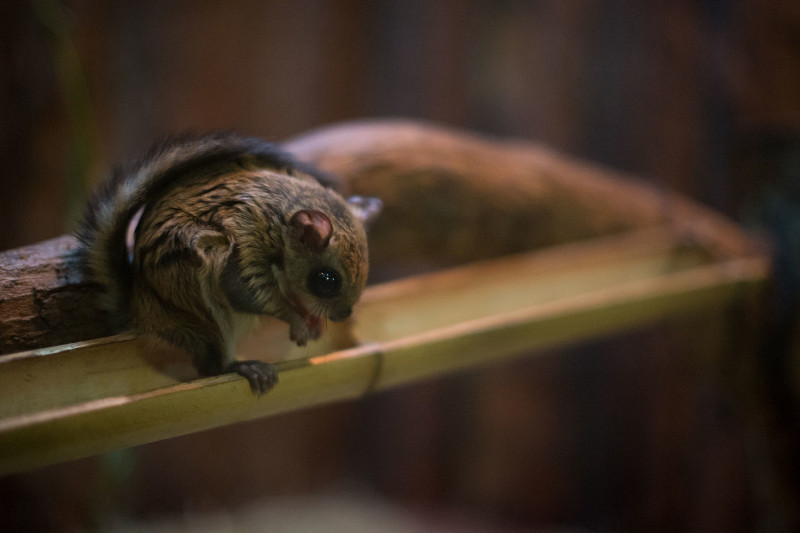
Japanese Dwarf Flying Squirrel Facts
- This precious creation of Nature and evolution most frequently goes by the english language common name of the Japanese Dwarf Flying Squirrel. For the moment, this marvelous small animal has no other accepted general designation in english.
- Within the scientific community, however, it’s perhaps much better known by its technical moniker. Unfortunately, though, like many such terms, it’s rather hard for the layperson to pronounce. That’s because it holds the epithet Pteromys momonga.
- The beautiful creature received that formal label due to the efforts of Coenraad Jacob Temminck. The respected Dutch zoologist accomplished the first acknowledgement of it as a separate and distinct species. He managed that noteworthy feat in 1844.
- Fortunately, the amazing Japanese Dwarf Flying Squirrel seems to be maintaining a stable and sizeable population base. That pleasant situation also appears to hold true across its range. The IUCN therefore currently lists the rodent as Least Concern.
- The intriguing mammal nevertheless should be considered as facing several potential threats to its existence, at least. As with other species, though, most of these stem from the actions of mankind. These include the perils of habitat loss and climate change.
Related Articles
Japanese Dwarf Flying Squirrel Physical Description
The gorgeous Japanese Dwarf Flying Squirrel is yet another remrakable variety of rodent. It quickly captures the attention of those fortunate enough to encounter it. It typically does so, however, due more to its pure beauty than to any impressive physical stature.
That’s due to the very nature that earns it the appellation it holds. Compared to its many relatives around the globe, it’s quite small in size. Much like most of those same relatives, though, the species displays no visible degree of the trait of sexual dimorphism.
Distinguishing the genders visually thus presents a problem for the majority of untrained observers. Individuals of both sexes attain the same basic physical measurements in all respects. This includes length of body and tail alike, as well as bulk and mass.
Body length typically ranges from approximately 5.5 – 7.9 in (14 – 20 cm). The tail itself usually adds an additional 3.9 – 5.5 in (10 – 14 cm). That same appendage also tends to develop as quite fluffy in texture, and generally curls back toward the head when at rest.
The appearance of the amazing Japanese Dwarf Flying Squirrel also garners much appreciation. The fur on the upper side of the body typically displays a buffy gray to silver shade. On its underside, though, the wonder of Nature usually presents an off-white hue.
Like other flying squirrels, it also possesses a thin membrane that extends from its wrists to the ankles. Yet, it lacks the similar feature from the rear legs to the base of the tail common to others of its kind. It also shows small ears and comparatively outsized eyes.
- Kingdom: Animalia
- Phylum: Chordata
- Class: Mammalia
- Order: Rodentia
- Family: Sciuridae
- Genus: Pteromys
- Species: P. momonga
Japanese Dwarf Flying Squirrel Distribution, Habitat, and Ecology
The fascinating Japanese Dwarf Flying Squirrel evolved as native to a relatively tiny section of the surface of the earth. The nature of that zone of habitation probably won’t surprise anyone, however. That’s true since the awesome mammal developed within region of Asia.
To be more precise, as its name itself implies, it only lives within the borders of the country of Japan. Yet, even there it only appears on three of the islands. The animal’s only known on Kyushu, Shikoku, and Honshu. It’s unknown if it ever lived beyond this current range.
Like many of its relatives, it displays decidedly strong preferences regarding its choice of habitat. Due to this evolutionary trait, the species lives almost exclusively in areas consisting of one of two ecosystems. These consist of boreal evergreen forests and sub-alpine forests.
Yet, its tendency toward precise requirements doesn’t simply end with its general region. That’s because the diminutive creature also exhibits favoritism for where it constructs its nest. For this function, it mainly prefers conifers, such as spruce or pine, over other types.
The Japanese Dwarf Flying Squirrel also differs from many of its kindred in its behavioral pattern. This species evolved as primarily nocturnal in nature. During the day, the marvel of Nature spends most of its time resting in its nest, usually constructed in a hole in a tree.
It’s also principally herbivorous in its dietary practices. The rodent mostly consumes pine seeds, nuts, buds, tree bark, and various fruits. The animal does, nevertheless, occasionally supplement this fare with insects. It also has a tendency to feed while hanging from a tree.
Species Sharing Its Range
Check out our other articles on 4 Fantastic Woody Shrubs of France, Eurasian Brown Bear, Mount Erebus, Spinetail mobula, Sicilian Fir, Axolotl, Great Potoo, Firebrick Starfish, Gila Monster
